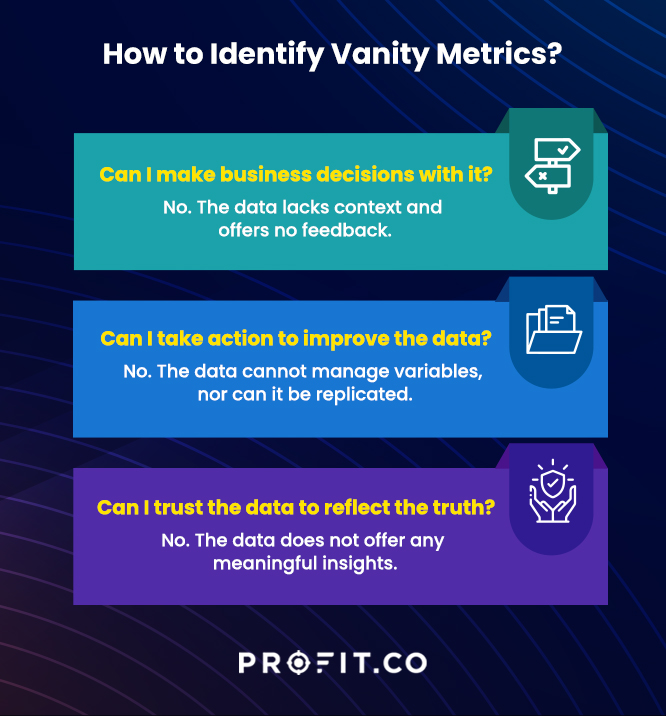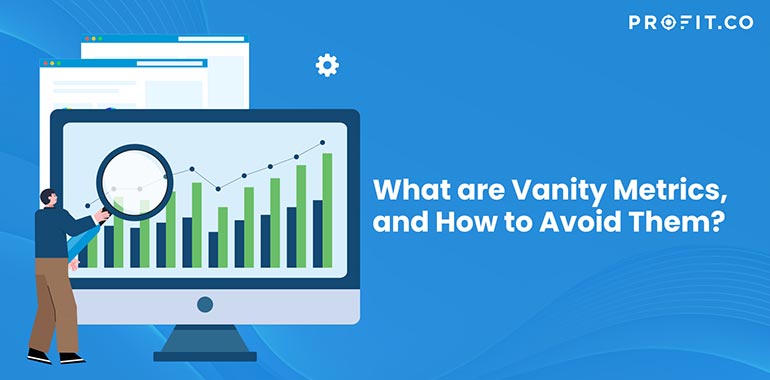Digital marketing metrics are the driving force behind digital marketing. While data is abundant, using the right metrics to measure the outcomes and using that as feedback to improve or enhance productivity is a vital marketing component.
Vanity metrics have been discussed amongst marketers for decades, as they are often used to measure success.
This article will cover
- Definition of vanity metrics
- Differences between vanity and actionable metrics
- How to identify vanity metrics
- Examples of vanity metrics
- Frequently Asked Questions (FAQs)
Definition
The vanity metrics make your business appear good to outsiders. However, they don’t help you assess your performance in ways that guide future strategies.
In addition to being unable to indicate true success for a brand or product, vanity metrics often fail to tell the whole story behind user engagement. They only measure surface-level interactions without any context as to why people are engaging with your content in the first place.
Vanity metrics might appeal to marketers who want to show progress and growth.
Unfortunately, they don’t always translate into meaningful results like increased sales or conversions.
The ultimate purpose of collecting the data is to provide a basis for action or a recommendation.
Characteristics of Vanity Metrics
Vanity metrics provide a surface-level view of your business or product’s performance but don’t necessarily offer any actionable insights.
These metrics may look good, but they can be misleading and unhelpful when making informed decisions.
There are several common characteristics of vanity metrics, including:
- The metric lacks context and nuance
- It has no substance
- Provides misleading information
- It doesn’t assist in business or product improvement in a meaningful way
- It’s too easy to measure
Context is critical to any metric. If a metric lacks context, then it has little or no value. What are key metrics is a strategic business decision that can have a recurring impact.
OKR methodology is a goal management platform that allows you to define your objectives with measurable key results. Book a free demo with our team to learn more about how OKR software can help you identify the key metrics to optimize your organization’s performance!
Differences Between Vanity Metrics and Actionable Metrics
The main difference between vanity and actionable metrics is that the former provides a superficial view of performance. At the same time, the latter offers more meaningful insights.
Vanity metrics are measurements that show progress and growth but don’t necessarily lead to any tangible results.
It’s also important to note that vanity metrics only measure initial interactions with content. They don’t tell you what people do after engaging with the material (e. g., if someone clicked through from an ad) nor why those users got motivated in the first place.
On the other hand, actionable metrics are measurements you can use to inform decisions and drive actual outcomes.
These types of analytics focus on user engagement, such as click-through and conversion rates. They reveal how people interact with content after engaging with it and what motivates the action.
Therefore, focusing more on smart metrics with actionable data than vanity ones will give you a clear understanding of your marketing efforts.
Why Marketers Use Vanity Metrics
Marketers use vanity metrics because they are simple to track and measure. These characteristics make them attractive to people who want to show progress and growth quickly.
You can easily track vanity metrics such as page views, likes, shares, and followers on social media sites with just a few clicks.
This makes it easy to gauge your business or product’s performance without devoting too much time or resources to the process.

Identifying Vanity Metrics
How Can You Identify Vanity Metrics?
Identifying vanity metrics can be tricky, as they often look good on the surface. The most effective way to identify vanity metrics is by considering these three questions:
- Which Business Decisions Can This Metric Help?
It can be challenging to evaluate data to determine what’s helpful and what only appears good. You can quickly tell a vanity metric by asking whether the metric can guide a decision or prompt a course of action.
Actionable metrics should have context and offer feedback about whether what you’re doing in your business is working. We should be able to test the data to enhance or grow the business.
- What Intentional Actions Can You Take to Reproduce the Outcome?
You can also identify a vanity metric by determining whether the data allows you to control cause and effect.
For instance, your content becoming viral and earning high page views is excellent. However, it becomes useless if you can’t replicate it to build on that success.
If you can’t manage the variables and replicate the process to generate similar results, it will be impossible to enhance that process. The metric lacks value if there’s no way to strengthen it.
- Does the Data Reflect the Real Truth?
Some people promise better data with online marketing if you spend extra money. For instance, social media metrics look fantastic, but paying more followers eliminates their reliability.
Paying makes your brand’s followers a vanity metric. It would otherwise be a great metric if you used the insights to optimize your page for organic followers.
How to Avoid Vanity Metrics and Identify the Best Actionable Metrics
When measuring your marketing success, it’s essential to avoid vanity metrics and focus on actionable metrics instead.
To identify the best actionable metrics for your business or product, take the time to understand what drives user engagement. This will help you generate Market qualified leads (MQL) and Sales qualified leads (SQL). It could be anything from the click-through rate from an ad campaign to the conversion rate when someone purchases a product after viewing related content.
Once you understand better why people are engaging with your content in the first place, you can make data-driven decisions. You can focus on actions that offer more meaningful insights than just looking at superficial numbers like page views or likes.
Examples of Vanity Metrics
Vanity metrics are superficial measurements that look impressive but don’t lead to tangible results. Common vanity metrics include page views, likes, shares, and followers on social media.
The most common telltale sign of vanity metrics is that they are ever-growing and keep getting bigger and better. Some metrics that can easily become vanity are:
- Social media followers
- Registered users
- Raw pageviews
- Downloads
- Running totals of downloads or purchases
- New users or sign-ups gained per day
- Running number of total customers
FAQs
- What Are Vanity Metrics?
Vanity metrics are measurements that need to provide meaningful insights. These metrics often give an illusion of success, but they don’t tell you anything about how people use your product or service.
- What Are Actionable Metrics?
Actionable metrics measure real user interactions, such as purchase rates and time spent using the product.
This type of data provides much richer insights into customer behavior. You can use it to inform decisions about improving products and services for better results in the future.
- How Do I Identify Vanity Metrics?
To identify vanity metrics, look for those unrelated to customer behavior or directly tied to how people interact with your product or service.
Additionally, compare your performance against industry averages. If those numbers are significantly higher than yours, this could indicate that the metric isn’t helping you achieve your goals.
Conclusion
Vanity metrics have been an essential part of marketing for a long time. By understanding how to identify them, you can avoid using them and narrow down the best actionable metrics to help achieve your desired results.
Remember that while clicks or impressions may be vanity metrics, they can still be helpful indicators if appropriately used in combination with other actionable metrics.
If you are still deliberating if your chosen metric is vanity, feel free to refer back to these examples. You can get started on Profit.co completely free today to learn all about OKRs and metric-driven key results to track the progress of your business.

